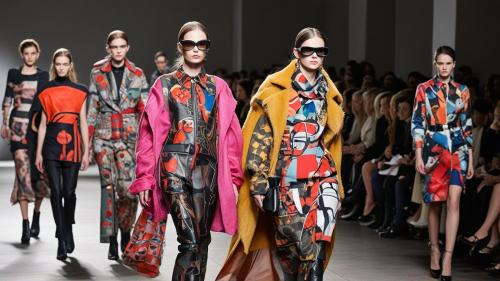subverting tradition: how avant-garde designers are redefining fashion week

In the ever-shifting realm of haute couture, a bold cadre of avant-garde designers is shaking up the staid traditions of Fashion Week. By embodying a more idiosyncratic and often provocative fashion statement, these designers are subverting conventional norms to redefine what catwalks, collections, and creativity mean in the world of style.
The once-rigid lines between wearability and artistic expression are blurring thanks to trailblazers like Demna Gvasalia, Rei Kawakubo, and Iris van Herpen. Their collections bypass the mainstream in favor of the daring and deconstructed. It’s a vibrant display where narratives engulf mere aesthetics, and fabrics speak louder than ever before.
These designers defy the limits of fabric and form by embedding messages in each crafted piece, often speaking to broader sociopolitical concerns. Balenciaga’s Demna, for instance, has utilized his platform not merely to display chic apparel but to comment on global crises, pushing the envelope from fashion to activism.
As this shift takes place, the role of fashion critics and aficionados is ever more crucial. They are tasked not only with evaluating the aesthetics but probing the philosophies underpinning each collection. It’s a new landscape where the runway is a battleground, and the attire is armor.
While Paris and Milan have long been arbiters of elegance and class, avant-garde has spotlighted cities less traditionally revered for their fashion influence. Designers from Tokyo, Amsterdam, and even Lagos are now commanding global attention, showcasing radical, genre-bending works that speak to a universal audience. It is this eclectic fusion that keeps the fashion industry electric and endlessly surprising.
Moreover, the industry’s pivot towards sustainability is mirrored in the avant-garde movement’s choice of materials and methods. More designers are focusing on recycling, upcycling, and the ethical sourcing of materials, crafting collections that are as much environmental statements as they are sartorial spectacles.
Graceful garments made of mushroom leather or exquisite pieces adorned with electronic components aren't mere flights of fancy but statements about fashion's potential for dialogue and engagement with technology and ecology. This fusion is not just a meme but a marker for what fashion can achieve beyond aesthetics.
Yet, amid this dynamism, a question looms large: Is the traditional allure of high fashion losing its sheen to this new world order? Or is it merely evolving to encompass a more inclusive understanding of beauty and form?
The world of avant-garde fashion is undoubtedly a complex one—provocative, challenging, and transformational. It requires audiences to participate, critique, and, most importantly, feel. Perhaps that’s the ultimate beauty of it: an ever-iterating narrative, a glimpse into fashion’s limitless potential.
As Fashion Week continues to evolve, so too must its audience, critic, and creators. Together, they add depth and dimension to this whirlwind art form, ensuring that while the clothing may be avant-garde, the message remains eternal.
The once-rigid lines between wearability and artistic expression are blurring thanks to trailblazers like Demna Gvasalia, Rei Kawakubo, and Iris van Herpen. Their collections bypass the mainstream in favor of the daring and deconstructed. It’s a vibrant display where narratives engulf mere aesthetics, and fabrics speak louder than ever before.
These designers defy the limits of fabric and form by embedding messages in each crafted piece, often speaking to broader sociopolitical concerns. Balenciaga’s Demna, for instance, has utilized his platform not merely to display chic apparel but to comment on global crises, pushing the envelope from fashion to activism.
As this shift takes place, the role of fashion critics and aficionados is ever more crucial. They are tasked not only with evaluating the aesthetics but probing the philosophies underpinning each collection. It’s a new landscape where the runway is a battleground, and the attire is armor.
While Paris and Milan have long been arbiters of elegance and class, avant-garde has spotlighted cities less traditionally revered for their fashion influence. Designers from Tokyo, Amsterdam, and even Lagos are now commanding global attention, showcasing radical, genre-bending works that speak to a universal audience. It is this eclectic fusion that keeps the fashion industry electric and endlessly surprising.
Moreover, the industry’s pivot towards sustainability is mirrored in the avant-garde movement’s choice of materials and methods. More designers are focusing on recycling, upcycling, and the ethical sourcing of materials, crafting collections that are as much environmental statements as they are sartorial spectacles.
Graceful garments made of mushroom leather or exquisite pieces adorned with electronic components aren't mere flights of fancy but statements about fashion's potential for dialogue and engagement with technology and ecology. This fusion is not just a meme but a marker for what fashion can achieve beyond aesthetics.
Yet, amid this dynamism, a question looms large: Is the traditional allure of high fashion losing its sheen to this new world order? Or is it merely evolving to encompass a more inclusive understanding of beauty and form?
The world of avant-garde fashion is undoubtedly a complex one—provocative, challenging, and transformational. It requires audiences to participate, critique, and, most importantly, feel. Perhaps that’s the ultimate beauty of it: an ever-iterating narrative, a glimpse into fashion’s limitless potential.
As Fashion Week continues to evolve, so too must its audience, critic, and creators. Together, they add depth and dimension to this whirlwind art form, ensuring that while the clothing may be avant-garde, the message remains eternal.